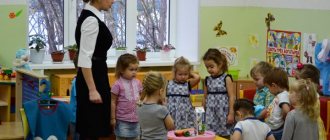Summary of GCD in the junior group on familiarization with the environment. Topic: “New Year at the Gate”
Summary of GCD in the junior group on familiarization with the environment.
Topic: “New Year at the Gate”
Integration of educational areas: “Cognition”, “Communication”, “Artistic creativity”.
Types of children's activities: educational and research,
communicative, gaming, musical and artistic, productive.
Target:
clarify and enrich children’s ideas about the upcoming event - the New Year holiday.
Tasks:
learn to look at objects (Christmas tree, Christmas tree decorations) and answer questions while looking at them;
Develop attention, speech, fine and gross motor skills, perception, creativity, independence;
Activate the dictionary on the topic “New Year’s holiday”;
Induce a joyful mood;
Cultivate friendly relations with each other.
Materials and equipment:
artificial Christmas tree (no more than 90 cm in height), a box with Christmas tree decorations made of safe material, a large sheet of Whatman paper with a pasted silhouette of a Christmas tree made of green paper (a painted Christmas tree), paper napkins of different colors; small silhouette Christmas trees cut out of white thick paper according to the number of children, colored pencils, easel.
Preliminary work:
watching the Christmas tree while walking, looking at paintings, illustrations on this topic, reading poetry, guessing riddles on this topic.
Progress:
1 part. Organizing time.
The teacher draws the children’s attention to the arriving guests and offers to greet them.
Surprise moment. There is a knock on the door. The teacher offers to see who knocked on the door. Having gone out the door, he returns with a Christmas tree and a box of New Year's toys, saying that Santa Claus passed by the kindergarten and left gifts for the children.
The teacher draws the children's attention to a small artificial Christmas tree and a box of Christmas tree toys.
Part 2. Clarification of the purpose of objects.
Questions:
- What is this? (Christmas tree, toys).
- What are toys for? (To decorate the Christmas tree).
— What holiday will be in kindergarten soon? (New Year).
Educator: For the holiday we will decorate the Christmas tree with Christmas tree toys (Takes out and shows toys from the box). And at the very top of the tree there will be a bright, beautiful star (Shows the star).
-What will we do at the holiday? (Sing songs, dance, dance around the Christmas tree).
- Who will come to our holiday? (Santa Claus, Snow Maiden, dads, moms).
-What are we going to tell them? (Poetry).
— What will Santa Claus bring in his big bag? (Present).
Part 3. Round dance around the Christmas tree (“Christmas tree”, music by E. Telicheeva, lyrics by M. Bulatov).
The teacher places the Christmas tree on the floor or on a low round table in the middle of the group and invites the children to dance around the Christmas tree.
Abstract of the educational activity “We are getting acquainted with the street” (lesson in the 2nd junior group)
Abstract of the educational activity “We are getting acquainted with the street”
(lesson in the 2nd junior group)
Target.
Introduce children to the street and its features; reinforce the rules of behavior on the street: you need to be careful, walk only on the sidewalk, on its right side, cross the street only at a specially designated zebra crossing; if you break these rules, you can get hit by a car.
Keywords:
names of parts of the street, transport. Material. Painting “City Street”, workbook.
Progress of the lesson
Children are asked to guess the riddle:
The houses stand in two rows. They look at each other with square eyes. (Street.)
The painting “City Street” is exhibited, children look at
her, a conversation is held on the following questions:
What is the street for? What parts is the street divided into?
What do you call people walking down the street? How should a pedestrian walk down the street?
Where can people cross the roadway? How do you know where the transition is?
Why do we need a zebra crossing and a traffic island?
Children are given a task. Draw a zebra crossing and a traffic island yourself on a piece of paper. Tell us why they are needed.
Offer the children to look at an illustration where a street is drawn; four children are walking along the left sidewalk, holding hands; they are noisily talking to each other, occupying the entire sidewalk. And a pedestrian is walking towards them - an adult man. He is forced to step off the sidewalk onto the roadway, and a car comes towards him.
The teacher asks the children a question: “Do children behave correctly on the sidewalk?” He clarifies with them: several people cannot walk on the sidewalk holding hands. Otherwise, you will take up the entire sidewalk and oncoming people will have to go down onto the roadway, and this is dangerous. A polite person will never jostle on the sidewalk. The sidewalk should be divided - let the left side be for pedestrians moving towards you.
The teacher offers to listen to a poem
They don’t just walk around the city, on the street:
When you don't know the rules, it's easy to get into trouble.
Be attentive at all times and remember in advance:
The driver and the pedestrian have their own rules. Summarize the lesson.
Lesson summary from the “Know Yourself” series in the second junior group
Tasks:
• Clarify and consolidate children's knowledge about the parts and organs of their body, their purpose;
• Develop skills in exploring objects using the appropriate senses;
• Develop speech-auditory attention, visual, auditory, tactile sensations;
• Cultivate a friendly attitude towards each other; caring for yourself.
Didactic.games:
“Say kindly and show”; “Guess who said? "; “What’s ringing? "; “Say a word”; “What did the artist forget to draw? »



